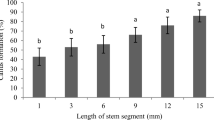Summary
In researching the application of genetic transformation to lily breeding, callus formation from cultured explants and plant regeneration from induced calluses were examined in 33 Lilium genotypes, 21 species, three Asiatic hybrids, two LA hybrids, two Longiflorum hybrids, three Oriental hybrids, and two Trumpet hybrids. Seed, bulb scale, leaf, or filament explants were placed on a medium containing 4.1 μM 4-amino-3,5,6-trichloropicolinic acid (picloram; PIC) and cultured in the dark. After 2 mo., callus formation was observed in 30 genotypes, and a formation frequency of more than 50% was obtained in 24 genotypes. Bulb scale and filament explants showed great ability to form calluses, whereas seeds had poor ability. Most of the induced calluses were yellow and had a nodular appearance. When subcultured onto the same fresh medium, twofold or more increases in callus mass were obtained in 1 mo. for 15 genotypes. Callus lines showing sustained growth 1 yr after the initiation of subculture were examined for their ability to produce shoots on a medium without plant growth regulators (PGRs) and a medium containing 22 μM 6-benzyladenine (BA). Shoot regeneration was observed in all genotypes examined, and a regeneration frequency of over 80% was obtained in 20 genotypes. Initial explants used for callus induction and callus type (nodular or friable) had no effect on shoot regeneration. Most of the regenerated shoots developed into complete plantlets following their transfer to a PGR-free medium.
Similar content being viewed by others
References
Arzate-Fernandez, A.-M.; Nakazaki, T.; Okumoto, Y.; Tanisaka, T. Efficient callus induction and plant regeneration from filaments with anther in lily (Lilium longiflorum Thumb.). Plant Cell Rep. 16:836–840; 1997.
Comber, H. F. A new classification of the genus Lilium. Lily Year Book RHS 13:86–105; 1949.
Godo, T.; Kobayashi, K.; Tagami, T.; Matsui, K.; Kida, T. In vitro propagation utilizing suspension cultures of meristematic nodular cell clumps and chromosome stability of Lilium × formolongi hort. Sci. Hortic. 72:193–202; 1998.
Godo, T.; Matsui, K.; Kida, T.; Mii, M. Effect of sugar type on the efficiency of plant regeneration from protoplasts isolated from shoot tip-derived meristematic nodular cell clumps of Lilium×formolongi hort. Plant Cell Rep. 15:401–404; 1996.
Godo, T.; Mii, M. Regeneration of plants from protoplasts of Lilium × formolongi. In: Bajaj, Y. P. S., ed. Biotechnology in agriculture and forestry, vol. 38 Berlin and Heidelberg: Springer-Verlag; 1996:79–89.
Hoshi, H.; Kondo, M.; Mori, S.; Adachi, Y.; Nakano, M.; Kobayashi, H. Production of transgenic lily plants by Agrobacterium-mediated transformation. Plant Cell Rep. 22:359–364; 2004.
Mii, M.; Yuzawa, Y.; Suetomi, H.; Motegi, T.; Godo, T. Fertile plant regeneration from protoplasts of a seed-propagated cultivar of Lilium×formolongi by utilizing meristematic nodular cell clumps. Plant Sci. 100:221–226; 1994.
Murashige, T.; Skoog, F. A revised medium for rapid growth and bioassays with tobacco tissue cultures. Physiol. Plant. 15:473–497; 1962.
Nakano, M.; Sakakibara, T.; Suzuki, S.; Saito, H. Decrease in the regeneration potential of long-term cell suspension cultures of Lilium formosanum Wallace and its restoration by the auxin transport inhibitor, 2,3,5-triiodobenzoic acid. Plant Sci. 158:129–137; 2000.
Priyadarshi, S.; Sen, S. A revised scheme for mass propagation of Easter Lily. Plant Cell Tiss. Organ Cult. 30:193–197; 1992.
Simmonds, J. A.; Cumming, B. G. Propagation of Lilium hybrids. II. Production of plantlets from bulb-scale callus cultures for increased propagation rates. Sci. Hortic. 5:161–170; 1976.
Stimart, D. P.; Ascher, P. D.; Zagorski, J. S. Plants from callus of the interspecific hybrid Lilium ‘Black Beauty’. HortScience 15:313–315; 1980.
Suzuki, S.; Niimi, Y.; Sakakibara, T.; Hosokawa, K.; Yamamura, S.; Nakano, M. Effects of several antibiotics and bialaphos on the growth and organ formation of Lilium formosanum calli and transient expression of the gusA gene after co-cultivation with Agrobacterium tumefaciens. Plant Biotechnol. 15:213–216; 1998.
Tribulato, A.; Remotti, P. C.; Löffler, H. J. M.; van Tuyl, J. M. Somatic embryogenesis and plant regeneration in Lilium longiflorum Thunb. Plant Cell Rep. 17:113–118; 1997.
Wickremesinhe, E. R. M.; Holcomb, E. J.; Arteca, R. N. A practical method for the production of flowering Easter lilies from callus cultures. Sci. Hortic 60:143–152; 1994.
Author information
Authors and Affiliations
Corresponding author
Rights and permissions
About this article
Cite this article
Mori, S., Adachi, Y., Horimoto, S. et al. Callus formation and plant regeneration in various Lilium species and cultivars. In Vitro Cell.Dev.Biol.-Plant 41, 783–788 (2005). https://doi.org/10.1079/IVP2005707
Received:
Accepted:
Issue Date:
DOI: https://doi.org/10.1079/IVP2005707




